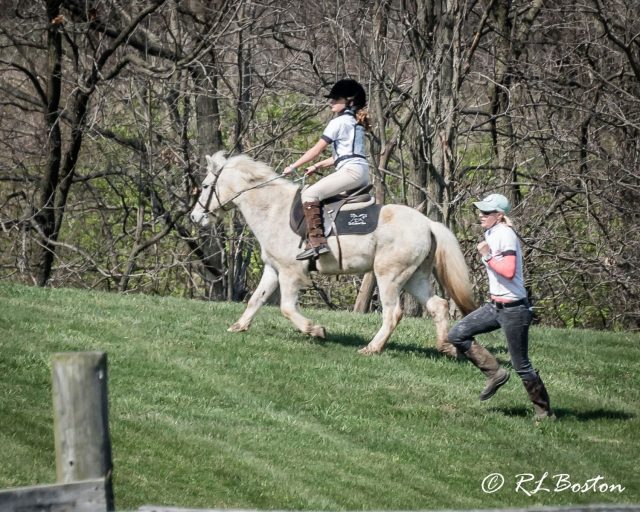I’m sore. I’m mad. I’m embarrassed.
In the sport of the eventing I know there are highs and lows. Although I guess it did not expect to hit a low (or the ground) at a schooling day in front of four students, two pony clubs, and our resident photographer.
The footing was perfect. The weather was a beautiful 73 degrees and sunny at Queeny Park in St. Louis. I had brought my up-and-coming 6-year-old Thoroughbred to work on some of the Training level questions, along with a handful of students who wanted to practice their levels before the upcoming horse trials. My young horse is bold and opinionated, and forgets to listen sometimes when he gets on course. But he has been to Queeny Park many times and stays relatively relaxed there, so I figured it would be a great day to show my students how it’s done.
From the get-go the day started out rough. While lifting the electric scooter out of the trailer for our photographer to use, it got stuck. It’s pretty heavy, so I gave it one final TUG to set it free, where I managed to pull the seat off of it and punch myself in the face with it! My adult pony clubber/photographer was just walking up to witness this misfortune. Laugh it off, it’ll be a good day, I thought as my jaw throbbed.
Then, as one of my students was tacking up a lesson horse, she asked where I had put the bridle and girth. My heart sank. I realized I forgot to bring it! In my haste to pack the trailer, I left it hanging in the tack room! Thank goodness one of the other students met us there with her own trailer, as she had just come from a show. She happened to have spare tack, same bit and everything, that fit perfectly. Our lesson horse got to wear fancy show tack at the schooling day and was the best dressed all day! People forget things, it’s OK, we made it work!
We hacked about a mile or so to get to the first set of questions that we were going to tackle for the day. A couple of coops, logs, and a smaller bank complex. We started by walking up the small bank and over the grass. Then let’s trot up the slightly larger bank. Easy peasy. Even the less experienced students were having a great time.
“I’m going to do the larger up bank, three stride, to the down bank, before we move on to the next set of questions,” I said. I would show them how to ride it. “Your shoulders are the most important piece. Use a longer rein on the drop, let your horse use his head and neck for balance, shoulders back and look at the horizon!” I’ve done these banks a million times and do a 5’6” drop with my upper level OTTB.
I started by trotting towards it, but my over-enthusiastic thoroughbred decided we need to canter. No big deal, I’ll slow him down before the drop. Now mind you I have a very bad habit of looking down over drops. I have built drops at my farm specifically it to practice this issue. I just can’t help myself. So when he got going too fast, and I couldn’t get him slow down for the drop, my poor instincts kicked in. Surely I should lean over and look down!

Photo by RL Boston.
I know this is wrong. I can’t stop myself. My shoulders dipped forward. I know this is also wrong. So when this eager young horse launched himself into the abyss, and “bam” … landed hard on the flat ground, then lurched forward with a commanding canter stride, I crumpled right off the side of him. I was STILL looking down. The whiplash I felt through my body was minimal compared to that of my self confidence.

Photo by RL Boston.
The good thing is he did not run off, so I did not have to chase after a young Thoroughbred in the middle of a 200-acre cross country course. However, I knew when I hit the ground that I had an audience. I heard a crunch when I hit the ground. Was that my neck or my pride? My students were silent. Pony clubbers and their parents were silent. The photographer had stopped clicking. I am supposed to instill confidence in them, not come flying off my green horse. I popped up like a gopher, trying to laugh and smile.
“I’m okay, I’m okay, let me get back on and do that again.” (laughs uncomfortably) I explained to my students that that is NOT how you were supposed to ride that. “You should actually look at the horizon, not look down. Now we can all learn from what I did wrong!” In my heart I was devastated. How can they look to me for guidance when I come flying off at a simple bank complex? Will they be nervous now the rest of the schooling day because their trainer fell?
These are the highs and lows of eventing. No, I didn’t fall off at the Head of the Lake at Rolex. I did not forget my dressage test at Badminton. As strange as it sounds, while I never wish for upper level riders to have a fall, a run out, or make a mistake, I take some comfort in the fact that those four-star riders are in fact, human. I’m human too. I made a mistake. Time to get back on. Pick my chin up. Try again. And be certain to not look down! Because as low as this sport can make you feel, I’ll take that any day if I get to experience the high of leaving that starting box one more time.
“3, 2, 1 … Have a good ride!”





































